Video games are serious business for Blizzard CEO Michael Morhaime
The gig: Chief executive and co-founder of Blizzard Entertainment Inc., maker of mega video game franchises including World of Warcraft, one of the most popular online video games in history with more than 11 million monthly subscribers. Morhaime and two fellow UCLA students started Blizzard in Irvine in 1991. The company just released an intergalactic war game called StarCraft II, which took five years to complete. Morhaime, 42, captains the long voyages from the games’ inception to their release. In his nearly 20 years at Blizzard, the Northridge native has gone from a full-time code monkey to the big gorilla at a company whose Warcraft game alone brings in close to $1 billion for its parent company, Activision Blizzard.
Game on: In sixth grade, Morhaime pooled funds with his brother and sister to buy an early video game console called the Bally Professional Arcade, first released in 1978. Morhaime discovered that the device was programmable, and he figured out how to write simple games on it, with the help of example programming code he found in a monthly gaming newsletter.
“I knew the day it would come out, so I’d go wait at the mailbox, take it to school with me, and just read that thing over and over again to try to figure out how all the programs worked,” he said. “I was so excited about how cool it was that you could get this machine to do things.”
Powering up: As an electrical engineering student at UCLA, Morhaime took a detour from games for a while to understand the nuts and bolts of the computers that ran them. Was he a model student? “I procrastinated a lot,” he admitted. But things changed after he got an internship at a San Jose microchip company. He read everything he could about circuit design, and by the time he got back to school he knew more than anyone else in his computer architecture class.
“I used to be the guy that sat in the back,” he said. But after his stint in Silicon Valley, he said, “I started sitting up front.”
Multiplayer action: Around that time, Morhaime met the two people with whom he would launch Silicon & Synapse, the company that would become Blizzard. The young founders — Morhaime, Allen Adham and Frank Pearce — rented a 650-square-foot office in Irvine to be close to other gaming companies.
“We bought three desks from an office supply store and built them ourselves,” he said.
During their first year, the group was paid $40,000 by a larger game publisher to build RPM Racing, a car game for the Super Nintendo system. The game sold modestly; not a blockbuster, but enough to get the guys a contract to do two more titles.
Big boss: With a couple of years and a half-dozen games under its belt, Blizzard began releasing its own original games. Games like Lost Vikings and Warcraft: Orcs and Humans that grew to focus on Tolkien-esque worlds of magic, monsters and heroes.
In 1995 Blizzard released Warcraft II, its first No. 1-selling game. “It’s probably the game that put Blizzard on the map,” Morhaime said. Besides its brisk sales, “it was the first game you could play over the Internet with a good experience” — a characteristic that would come to define Blizzard’s later games.
Next level is the hardest: Blizzard’s greatest success came with a tough lesson. In planning for the release of World of Warcraft (WoW) in late 1996, Morhaime thought the market for the much more expansive new game — the first that required players to pay for a subscription — would start off slowly.
“We felt it was very likely the fee would be a deterrent for people, and that WoW would not sell as quickly as some of our previous games,” he said. All of Blizzard’s production decisions were based on that conservative projection.
But to Blizzard’s delight, and terror, WoW sold furiously, leaving the underprepared Blizzard temporarily unable to keep stores stocked with the game. “For the whole first year, we scrambled to keep up with demand,” he said. “It probably took years off of our lives.”
The success of WoW, however, also helped boost Blizzard, owned then by French conglomerate Vivendi, into a $1.7-billion merger with fellow game company Activision Inc., to become the nation’s largest video game developer.
For the win: Unlike many games designed to keep players interested for only a few days or weeks, Blizzard’s “immersive” virtual worlds attract gamers who stay and pay for months or years. However loud the clamor may get for the company to hurry up and finish its games, building a whole world takes time, Morhaime says, and you only get one shot to get it right.
“You should take your reputation very seriously and try to build a track record you can be proud of,” he said. “There’s no such thing as ‘next time we’ll do it better.’ Do it better this time.”
david.sarno@latimes.com






